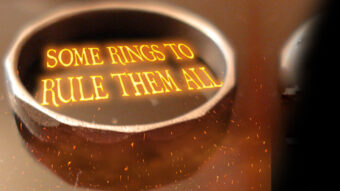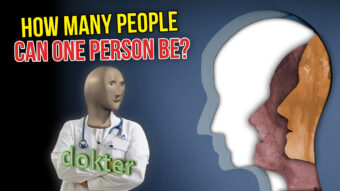
David Charles Hahn was born on October 30, 1976, in Royal Oak, Michigan to Ken and Patty Hahn. His parents divorced when he was very young and for most of his childhood he spent his weeks with his father, a GM automotive engineer, and his weekends with his mother and her boyfriend Michael Polasek, a GM forklift driver. Despite being constantly shuffled between households, David’s early childhood was relatively normal. He joined the Boy Scouts, played baseball, and spent hours playing with his friends, though he remained a relatively shy and withdrawn child. An indifferent student and a terrible speller, he fell behind in school, nearly failing his state math and writing exams. But according to his science teacher Ken Gherardini, David was fascinated with chemistry and could be an extremely bright student when the class aligned with his interests:
“His dream in life was to collect a sample of every element on the periodic table. I don’t know about you, but my dream at that age was to buy a car.”
A major turning point in his life came when his stepmother, Kathy Missig, gave him a copy of The Golden Book of Chemistry Experiments. Published in 1960, the book was a monument to mid-century scientific enthusiasm, filled with passages proclaiming how chemistry can uplift humanity and create a brighter tomorrow. It also contained experiments that would be unthinkable in a modern children’s textbook, such as how to make chloroform and nitroglycerine. The book was a revelation, promising David an escape from the trauma of divorce and life as a teenager. He set up a chemical laboratory in his bedroom, stocking it with beakers, flasks, bunsen burners and other equipment both purchased and homemade. Soon the house was plagued with frequent explosions, chemical spills, and clouds of toxic gases, much to his parents’ growing concern. After one incident where a sample of phosphorus exploded in David’s face, resulting in him being rushed to the emergency room to have shrapnel extracted from his eyes, Patty and Michael banished David’s laboratory to the backyard potting shed. This suited David just fine, as it allowed him to carry out his experiments in greater privacy.
Though David’s parents were secretly proud of his industriousness, their limited education prevented them from comprehending his experiments, and they remained wary and distant. To his staunchly blue-collar father, David’s chemical dabblings were merely a cry for an attention and represented a lack of discipline and direction. He thus attempted to steer his son towards a more traditional goal: achieving the rank of Eagle Scout. But if Ken Hahn thought this would curb David’s scientific enthusiasm, he was to be proven spectacularly wrong, for David managed to find a way to indulge his real passions by pursing the Atomic Energy Merit Badge. He contacted Government nuclear agencies for information, drew diagrams explaining nuclear fission, visited a hospital radiology lab to learn about x-rays and nuclear medicine, and built a scale model of a nuclear reactor from tin cans and drinking straws. But David still wasn’t satisfied; soon after earning his badge on May 10, 1991, he made the fateful decision to try and build a working breeder reactor.
Breeder reactors are designed to produce more nuclear fuel than they consume. This is typically done by surrounding the core in a blanket of “fertile” non-fissile material, which is converted to fissile isotopes as by absorbing neutrons from the nuclear reaction. For example, non-fissile Uranium-238 can be converted to Plutonium-239, and Thorium-232 to Uranium-233. None of these isotopes were readily available, so posing as a high school physics teacher, David contacted various private companies and Government departments looking for information. From Donald Erb, the Nuclear Regulatory Commission’s director of isotope production and distribution, David learned how certain radioisotopes could be generated by bombarding ordinary elements with neutrons, and how to construct a working neutron source.
The first thing David needed was a source of Alpha particles. Knowing that smoke detectors contained the isotope Americium-241, Hahn contacted a fire safety company and convinced them to sell him 100 broken detectors at $1 each. He also attempted to steal smoke detectors from the scout summer camp, an act which got him thrown out of the camp. After cracking open the detectors and extracting the radioactive sources, Hahn used a blowtorch to melt them into one large lump. This he placed in a hollow block of lead with a small pinhole to let out the Alpha particles. In front of this hole he placed a piece of Aluminium to convert the Alpha particles into neutrons, and in front of this a block of paraffin wax to convert the neutrons into electrons. When the steady crackling of his mail-order Geiger counter confirmed that the source was working, Hahn set off in search of fertile material to convert into fissile radioisotopes.
At first he tried to obtain Uranium, searching the shores of Lake Michigan with his Geiger counter. But when this turned up only a trunkful of pitchblende, an oily-black Uranium ore, David, posing once again as a high school teacher, contacted a Czechoslovakian firm specializing in university sales and managed to obtain some samples of Uranium dioxide. He attempted to purify this oxide by mixing it homemade nitric acid and passing it through a coffee filter, but this yielded only unusable black sludge. David thus switched to Thorium, which he knew was found in cloth gas-lantern mantles. After buying as many mantles as he could find in sporting goods stores, David used a blowtorch to turn them into ash. He then bought $1000 worth of Lithium batteries, extracted the Lithium, and wrapped it and the Thorium ash in tinfoil before heating it with the blowtorch. This caused the Lithium and the Thorium to switch places, purifying the Thorium to a level 9000 times higher than found in nature. David then placed his Thorium and Uranium in front of his neutron source and waited, monitoring the radiation every day with his Geiger counter.
Unfortunately, neither sample showed any increase in activity, so after consulting once again with Donald Erb at the NRC, David set out in search of a stronger Alpha particle source: radium paint from old luminous clock dials. He scoured second-hand stores for old clocks, scraping the glowing green paint into pill bottles, then purified the radium using nitric acid before using it to replace the Americium in his neutron source. To further increase the neutron yield, at Donald Erb’s suggestion he replaced the aluminium with beryllium, which a friend of his swiped from his school’s chemistry lab. This time the neutron source finally yielded results, with the activity of the Thorium and Uranium steadily rising day by day. Having successfully transmuted elements, David was now ready to build his breeder reactor.
David Hahn’s reactor was as crude as his other creations, consisting of small tinfoil-wrapped cubes of radium paint, americium, and thorium ash duct-taped into an assembly around the size of a shoe box. While this device could never have achieved criticality and sustained a chain reaction, it did produce a lot of radiation – so much in fact, that Hahn could detect it all the way down the street Having read that real reactors use cobalt control rods to moderate the reaction, Hahn purchased cobalt drill bits and inserted them into his assembly. When this had no effect, David realized that he had too much radioactive material in the shed and partially disassembled the reactor, placing it and much of his other equipment in the trunk of his car. Unfortunately, it was this decision that would lead to his eventual discovery.
At 2:40 AM on August 31, 1994, the Clinton Township police received a tip about a young man stealing tires from a vehicle, and arrived to find David Hahn waiting in his car. Unconvinced by Hahn’s explanation that he was just waiting for a friend, the officers decided to search the vehicle. In the trunk they discovered an assortment of mysterious-looking objects, including a toolbox sealed with tape, fifty tinfoil cubes filled with grey powder, and assorted bottles of chemicals. Fearing that they had found a bomb, the officers impounded the vehicle and brought Hahn into the police station for questioning. David was uncooperative, refusing to speak about the contents of his trunk or reveal the location of his potting shed laboratory until the police brought in a radiological expert from the Department of Public Health to question him. Based on Hahn’s confession, the Nuclear Regulatory Commission and the Environmental Protection Agency launched an investigation, descending on the Hahn household to inspect the potting shed. What they found shocked them: nearly every object in the shed was emitting radiation over 1000 times higher than ordinary background levels. Little did they know that Patty Hahn, fearing that the radiation would cause her to lose her house, had actually thrown most of David’s equipment in the trash. Following their inspection, the EPA declared the shed a Superfund cleanup site.
On June 26, 1995 – nearly a year after David Hahn’s arrest – EPA officials descended upon the Hahn residence, dismantled the potting shed, and packed it and the soil beneath it into 39 barrels, which were transported to a low-level nuclear waste facility in Utah. The cleanup took three days and cost $60,000. The EPA encouraged David to be evaluated for radioactive exposure at the nearby Enrico Fermi nuclear power plant, but he refused, apparently frightened by what he might discover.
Following the cleanup, David Hahn fell into a deep depression. Not only had several years of work and his life’s purpose been destroyed, but his classmates had began to tease him, calling him “radioactive boy.” His scout leaders even attempted to revoke his Eagle Scout status for endangering the community. Worse still, his parents had grown weary of his lack of direction and demanded that he enrol in college. David majored in metallurgy at Macomb Community College but skipped many of his classes, forcing his parents to issue an ultimatum: join the military or get out. David chose the navy, and after completing boot camp was stationed aboard the nuclear-powered aircraft carrier U.S.S. Enterprise. Unfortunately for David’s nuclear ambitions, as a regular seaman his shipboard duties were purely menial and he was never allowed anywhere near the carrier’s eight reactors. However, he remained optimistic, stating to journalist Ken Silverstein in 1998:
“I wanted to make a scratch in life. I’ve still got time. I don’t believe I took more than five years off of my life.”
But while he might have been right, the years ahead were likely not what he had imagined. After a four-year tour in the Navy David joined the Marines, reaching the rank of Lance Corporal before being honourably discharged on medical grounds. After this, he fell into a spiral of depression, alcoholism and drug abuse, and soon returned to old habits. In April 2007 the FBI received a tip that David Hahn was in possession of another neutron source. While they determined he not an imminent terrorist threat, they did perform a personal interview, during which David’s deteriorated mental state became frighteningly apparent. While in the navy David had been diagnosed with paranoid schizophrenia, but was not taking his prescribed medication. He was abusing cocaine heavily and had become paranoid of people he claimed had the ability to “shock his genitals with his mind.” He had also gone back to collecting radium and americium in an attempt to build another reactor. In August of that year, David was arrested and charged with larceny after trying to steal smoke detectors from his apartment building. He plead guilty and served 90 days in prison, then fell once again into obscurity. Then, on September 27, 2016, David Hahn was found dead in his apartment, the victim of an accidental overdose of alcohol and fentanyl. He was 39 years old.
The story of David Hahn is a tragedy of missed opportunity. Though not a good student in the conventional sense, he was nonetheless extremely bright and highly resourceful, and lacked only the proper guidance to turn his scientific interests into a successful career. At the age of only 17 David Hahn had purified radioisotopes and built a working neutron source; with the right mentorship and direction, who knows what else he might have accomplished?
If you liked this article, you might also enjoy our new popular podcast, The BrainFood Show (iTunes, Spotify, Google Play Music, Feed), as well as:
- The Teenager Who was Executed Twice
- UPS Was Founded By Two Teenagers With One Bicycle and $100 Borrowed from a Friend
- The Teenage Girls Who Seduced and Killed Nazis
Silverstein, Ken, The Radioactive Boy Scout, Harper’s Magazine, November 1998, https://ift.tt/E8vxARp
Rauschenberger, Tim, The Nuclear Merit Badge, The Christian Science Monitor, March 16, 2004, https://ift.tt/nzQCI0e
Man Dubbed ‘Radioactive Boy Scout’ Pleads Guilty, Detroit Free Press, August 27, 2007, https://ift.tt/xs08DQI
The post That Time a Teenager Built a Nuclear Reactor in His Backyard appeared first on Today I Found Out.
from Today I Found Out
by Gilles Messier - May 31, 2022 at 02:43AM
Article provided by the producers of one of our Favorite YouTube Channels!
-

 “I, Simon Whistler, in the presence of these my betters and my equals in my Calling, bind myself upon my Honour and Cold Iron, that, of the best of my knowledge and power, I will not henceforward suffer or pass, or be privy to the passing of, Bad Workmanship or Faulty Material in aught that concerns my works before mankind as an engineer, or in my dealings with my own Soul before my Maker.”
“I, Simon Whistler, in the presence of these my betters and my equals in my Calling, bind myself upon my Honour and Cold Iron, that, of the best of my knowledge and power, I will not henceforward suffer or pass, or be privy to the passing of, Bad Workmanship or Faulty Material in aught that concerns my works before mankind as an engineer, or in my dealings with my own Soul before my Maker.” Looking back at the long and storied history of literature, film, and other narrative art forms, one trend becomes abundantly clear: writers love mental illness. From depression to bipolar disorder to schizophrenia, psychiatric disorders have been used by artists for hundreds of years to heighten drama, make heroes more heroic, villains more villainous, and allow actors to flex their acting chops – sometimes with unfortunate real-world implications. But few disorders have captured the imagination of writers and audiences like Dissociative Identity Disorder or DID – better known as Multiple Personality Disorder. Characterized by the expression of multiple distinct personality types by a single person – often accompanied by amnesia of each expression – DID has been featured in dozens of books and films from 1957’s The Three Faces of Eve and 1973’s Sybil to 1999’s Fight Club, 2009’s United States of Tara, and 2016’s Split. Given the disorder’s ubiquity in popular media, one could be forgiven for thinking that DID is a relatively common affliction, or at least one well-documented in the psychiatric literature. In reality, however, DID remains a poorly-defined, poorly understood, and highly controversial diagnosis, with many psychiatrists questioning whether the disorder even exists at all.
Looking back at the long and storied history of literature, film, and other narrative art forms, one trend becomes abundantly clear: writers love mental illness. From depression to bipolar disorder to schizophrenia, psychiatric disorders have been used by artists for hundreds of years to heighten drama, make heroes more heroic, villains more villainous, and allow actors to flex their acting chops – sometimes with unfortunate real-world implications. But few disorders have captured the imagination of writers and audiences like Dissociative Identity Disorder or DID – better known as Multiple Personality Disorder. Characterized by the expression of multiple distinct personality types by a single person – often accompanied by amnesia of each expression – DID has been featured in dozens of books and films from 1957’s The Three Faces of Eve and 1973’s Sybil to 1999’s Fight Club, 2009’s United States of Tara, and 2016’s Split. Given the disorder’s ubiquity in popular media, one could be forgiven for thinking that DID is a relatively common affliction, or at least one well-documented in the psychiatric literature. In reality, however, DID remains a poorly-defined, poorly understood, and highly controversial diagnosis, with many psychiatrists questioning whether the disorder even exists at all.


 Oh boy, we can already tell that the comment section for this one is going to be a ton of fun, so let’s just get straight to it. The Church of Scientology has a reputation as an infamously secretive and litigious organisation that hides its inner workings far from the prying eyes of the public. As a result, we kind of expected piecing together the church’s beliefs and stance on certain social issues to be a difficult, unforgiving slog. As it turns out, this wasn’t, on the surface, the case and the church is surprisingly forthcoming about both, although some feel there’s a veneer of insincerity in much of their official writings given what often leaks about their leadership to the press. It should also be noted that, as ever with any religion, beyond controversy within the church about specific precepts in terms of the official view verses what is practiced, individuals themselves can also practice the faith in their own unique ways, so saying what exactly the church believes is even more nebulous. Those caveats out of the way, let’s dive into it, shall we? So what do Scientologists believe?
Oh boy, we can already tell that the comment section for this one is going to be a ton of fun, so let’s just get straight to it. The Church of Scientology has a reputation as an infamously secretive and litigious organisation that hides its inner workings far from the prying eyes of the public. As a result, we kind of expected piecing together the church’s beliefs and stance on certain social issues to be a difficult, unforgiving slog. As it turns out, this wasn’t, on the surface, the case and the church is surprisingly forthcoming about both, although some feel there’s a veneer of insincerity in much of their official writings given what often leaks about their leadership to the press. It should also be noted that, as ever with any religion, beyond controversy within the church about specific precepts in terms of the official view verses what is practiced, individuals themselves can also practice the faith in their own unique ways, so saying what exactly the church believes is even more nebulous. Those caveats out of the way, let’s dive into it, shall we? So what do Scientologists believe?
 Utilised the world over, rubber bullets and stun guns are controversial additions to the arsenals of police forces and militaries due to their tendency to do the exact opposite of what they’re designed to do, rather than be non-lethal, occasionally killing the people they are leveled at. But how dangerous are they really?
Utilised the world over, rubber bullets and stun guns are controversial additions to the arsenals of police forces and militaries due to their tendency to do the exact opposite of what they’re designed to do, rather than be non-lethal, occasionally killing the people they are leveled at. But how dangerous are they really?